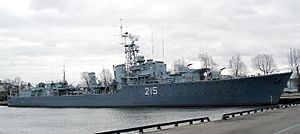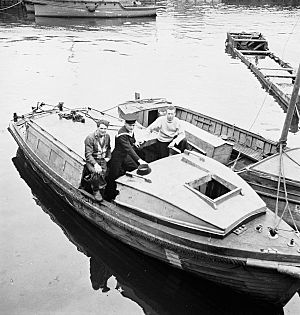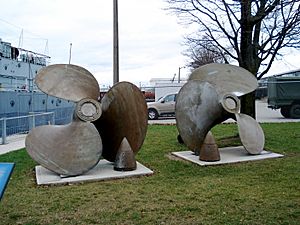HMCS Haida facts for kids
class="infobox " style="float: right; clear: right; width: 315px; border-spacing: 2px; text-align: left; font-size: 90%;"

HMCS Haida docked in Hamilton, Ontario, as a museum ship
|
|
| History | |
|---|---|
| Name | Haida |
| Namesake | Haida |
| Ordered | 5 April 1940 |
| Builder | Vickers-Armstrongs, Ltd., Newcastle-upon-Tyne |
| Yard number | 41 |
| Laid down | 29 September 1941 |
| Launched | 25 August 1942 |
| Commissioned | 30 August 1943 |
| Decommissioned | 20 March 1946 |
| Recommissioned | 15 March 1952 |
| Decommissioned | 11 October 1963 |
| Out of service | 22 February 1964 |
| Identification |
|
| Honours and awards |
|
| Status | Museum ship |
| General characteristics | |
| Class and type | Tribal-class destroyer |
| Displacement |
|
| Length | 377 ft (114.9 m) |
| Beam | 37 ft 6 in (11.4 m) |
| Draught | 13 ft (4.0 m) |
| Propulsion |
|
| Speed | 36.5 knots (67.6 km/h; 42.0 mph) (maximum), 32 knots (59 km/h; 37 mph) (service) |
| Complement | 259 (14 officers, 245 ratings) |
| Sensors and processing systems |
|
| Armament |
|
| Official name: HMCS Haida National Historic Site of Canada | |
| Designated: | 1984 |
HMCS Haida is a famous Tribal-class destroyer that served in the Royal Canadian Navy (RCN). She was active from 1943 to 1963. Haida played an important role in both World War II and the Korean War.
The ship was named after the Haida people, a First Nations group from Canada. She is the only surviving Tribal-class destroyer out of 27 ships built. These ships were made for the RCN, the Royal Navy, and the Royal Australian Navy.
Haida sank more enemy ships than any other Canadian warship. Because of this, she is often called the "Fightingest Ship in the Royal Canadian Navy".
Today, Haida is a museum ship and a national historic site of Canada. She is docked in Hamilton, Ontario, next to HMCS Star. In 2018, Haida was given the special title of ceremonial flagship of the RCN.
Contents
Building a Powerful Destroyer
The Tribal-class destroyers were designed to be strong warships. They were meant to fight other heavily armed destroyers. Canada chose this design because of its powerful weapons. These ships were large and strong, almost like small cruisers.
Haida was one of the first Tribal-class destroyers ordered by Canada. Her design included special heating and ventilation. This was to help her serve in the cold North Atlantic winters.
Haida was built in Newcastle-upon-Tyne by Vickers-Armstrongs, Ltd. Her construction began on September 29, 1941. She was launched into the water on August 25, 1942. The ship officially joined the RCN on August 30, 1943.
Ship Features and Weapons
Haida was about 377 feet (115 m) long. She was 36 feet 6 inches (11.13 m) wide and had a draught of 13 feet (4.0 m). When fully loaded, she weighed about 2,745 long tons (2,789 t). The ship had a crew of 14 officers and 245 sailors.
Two powerful steam turbines pushed the ship through the water. They gave her a top speed of 36.5 knots (67.6 km/h; 42.0 mph). This made her very fast for her time.
When first built, Haida had six 4.7-inch (119 mm) guns in three twin turrets. She also had one twin turret with 4-inch (102 mm) guns. For defense against aircraft, she had four 2-pounder "pom-pom" guns. Haida also carried four 21-inch (533 mm) torpedo tubes.
Haida in World War II
After joining the navy, Haida was sent to the British Home Fleet. In late 1943, she helped protect convoys of ships traveling to Russia. These were called Arctic convoys.
One important mission was escorting convoy JW 55B in December 1943. The German battleship Scharnhorst tried to attack the convoy. Haida and other destroyers helped keep the convoy safe. The Scharnhorst was later sunk by British forces.
Battles Along the French Coast
In January 1944, Haida moved to Plymouth, England. She joined the 10th Destroyer Flotilla. This group carried out missions in the Bay of Biscay and along the French coast. Their job was to find and fight German ships.
On April 25–26, 1944, Haida and other Allied ships fought German torpedo boats. Haida sank the German torpedo boat T29. Another German ship, T27, was damaged.
A few nights later, on April 28–29, Haida and her sister ship Athabaskan met the German ships again. Sadly, Athabaskan was hit by a torpedo and sank. Haida rescued 44 survivors from Athabaskan. Haida then chased T27, forcing it aground and setting it on fire.
Haida continued her patrols before the Normandy invasion. On June 8–9, she helped sink the German destroyer Z32. This happened in a battle near the Île de Bas.
On June 24, Haida and a British destroyer, Eskimo, sank a German U-boat called U-971. Haida rescued six survivors from the submarine. In July and August 1944, Haida took part in more battles. She helped sink several German patrol boats and minesweepers. During one battle, a shell exploded in one of Haida's gun turrets. Two sailors died, and eight were injured.
Final World War II Missions
Haida returned to Canada for repairs in September 1944. She came back to Europe in early 1945. She helped escort aircraft carriers and attacked German shipping off Norway.
In April 1945, Haida was part of the escort for convoy JW 66 to Russia. On the return journey, convoy RA 66 was attacked by German U-boats. Haida and her sister ship Huron were targeted by torpedoes but were not hit. This was one of the last battles for the RCN in World War II.
After the war ended in Europe, Haida was prepared for duty in the Pacific. However, Japan surrendered before she could go. Haida was taken out of service on March 20, 1946.
Haida in the Cold War
Haida was brought back into service in 1947. She received new weapons and sensors. Her 4.7-inch guns were replaced with 4-inch and 3-inch guns. She also got new anti-submarine mortars called "Squid".
When the Korean War began in June 1950, Haida was prepared for war again. She was refitted and recommissioned on March 15, 1952. She then sailed to Sasebo, Japan, to join the war effort.
Haida patrolled off the coast of Korea. She screened aircraft carriers and shelled enemy positions. On January 29, 1953, Haida destroyed an enemy train. She destroyed a second train on May 26. She also blew up a floating anti-ship mine.
After her first tour, Haida returned to Canada. She went back to Korea for a second tour in December 1953. Even though a cease fire was in place, a naval presence was still needed. She finished her second tour in September 1954.
After the Korean War, Haida took part in Cold War anti-submarine training. She worked with other NATO ships in the North Atlantic. By the late 1950s, Haida was getting old. She needed many repairs for corrosion and cracks.
Haida Becomes a Museum Ship
In 1963, Haida went on her last assignment, a summer tour of the Great Lakes. She visited many cities and towns. During this tour, a former sailor named Neil Bruce saw her. He realized she might be scrapped and wanted to save her. He formed a group called HAIDA Inc. to try and buy the ship.
On April 30, 1963, Haida was officially taken out of service for the last time. The Canadian government planned to scrap her. HAIDA Inc. offered $20,000 and won the bid to save her. The RCN towed Haida to Sorel, Quebec, where she became civilian property.
Haida was then towed to Toronto, arriving on August 25, 1964. Her first commanding officer, Harry DeWolf, was there for her arrival. She was restored and opened as an attraction in August 1965.
In 1970, Haida moved to Ontario Place in Toronto. She was a popular attraction there until 2002. Her guns were even fired when the Toronto Symphony played Tchaikovsky's 1812 Overture nearby! She was also used as a training facility for Royal Canadian Sea Cadets.
HMCS Haida National Historic Site
In 2002, Parks Canada bought Haida. She was towed to a shipyard for a $5 million refit. This was to repair her hull. On August 30, 2003, the 60th anniversary of her commissioning, Haida arrived at her new home. She is now on the Hamilton waterfront.
Today, Haida is a National Historic Site of Canada. She serves as a museum ship. Visitors can explore her decks and learn about her amazing history.
In July 2006, Haida was "twinned" with the Polish destroyer Błyskawica. Both ships served together in World War II. In 2009, Prince Charles and his wife, Camilla, Duchess of Cornwall, visited Haida. In 2010, Prince Philip, Duke of Edinburgh, presented an award to Haida representatives.
In 2016, Haida underwent more repairs and upgrades. In February 2018, she was named the ceremonial flagship of the Canadian Navy. This is marked by flying a special Haida tribal flag.
Organizations Connected to Haida
There is a Sea Cadet Corps named after the ship. It is the 186 Royal Canadian Sea Cadet Corps Haida, established in 1963. The museum is also connected to several important Canadian museum groups.
See also
- List of attractions in Hamilton, Ontario
- List of museum ships





